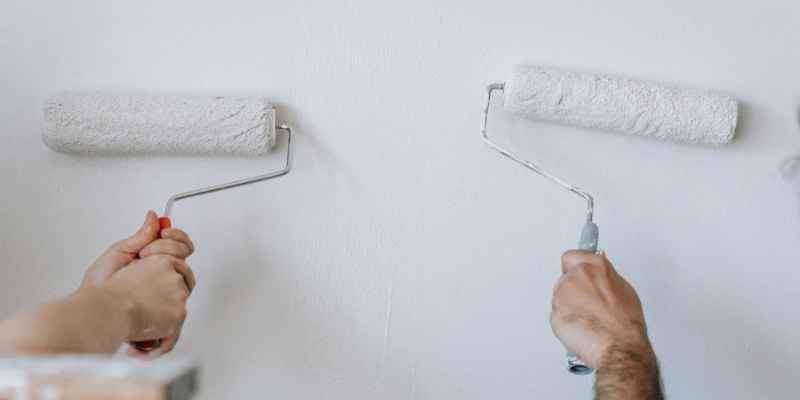Paint typically dries darker than its wet state. However, if the paint is mixed properly and the surface it’s applied to is consistent, the final dried color should still match the color swatch.
Factors that can affect the appearance of the dried paint include changes in texture and the evaporation of solvents or water. Paint is a versatile and commonly used medium for creating a variety of surfaces and finishes. Whether it’s painting a wall, furniture, canvas or any surface, it’s essential to know how the paint will appear once it dries.
Understanding whether the paint will become lighter or darker is crucial in achieving the desired results. We will explore the factors that influence the appearance of paint in its dry state and whether it changes color during the drying process. So let’s dive in to find out whether paint gets lighter or darker when it dries.
Factors Affecting The Paint Color
The color of paint generally stays consistent from the wet to the dry state, but there can be subtle differences in appearance due to changes in texture and the evaporation of water or solvents. Factors like wet versus dry appearance, finish type, and primer usage can affect whether paint appears lighter or darker when it dries.
Did you ever wonder whether paint gets lighter or darker when it dries? The answer is that the color of paint usually stays consistent from the wet to the dry state, but it can appear lighter or darker due to some factors. Here are some critical factors affecting the paint color:
Wet Vs. Dry Appearance
When it comes to paint color, the paint’s appearance can vary between wet and dry states. Wet paint may look darker than its final dry state. As the paint dries, water or solvents evaporate, and the paint pigment settles, resulting in a change in appearance. Depending on the color saturation and texture, the final result could appear lighter or darker.
Texture And Paint Type
The type of paint and its texture can also impact its final appearance. Matte or flat paint often absorbs more light, giving the appearance of slightly lighter color. In contrast, glossy paint’s reflective properties can make it appear darker. Additionally, different paint types have different properties, and even the same paint color may produce different results when using different types of paint.
Light Exposure And Environment
Light exposure and the environment can also affect paint color. The lighting in a room or environment can impact color perception. The color may appear lighter in bright lighting conditions and darker in dim lighting conditions. Even environmental factors like temperature and humidity can influence drying time, affecting the final outcome.
Conclusion
To summarize, whether paint gets lighter or darker when it dries depends on various factors, including the paint’s texture, type, light exposure, and environment. With this knowledge, it’s essential to consider these factors when selecting paint and to understand how to achieve the perfect color for your project.
Does Paint Get Lighter Or Darker As It Dries?
The color of paint generally stays consistent from wet to dry state, but subtle differences may occur due to changes in texture and evaporation of water or solvents. Paints typically dry darker, but if mixed properly, should look the same as the color picked out once dry.
The wet appearance may appear darker than the final dry state.
When it comes to painting, there are many questions that come to mind. One of the most commonly asked questions is, “Does paint get lighter or darker as it dries?” The answer is not a straightforward one, as it depends on various factors. The paint type, colour, finish, and even the lighting in the room can all contribute to whether the paint appears lighter or darker. In this article, we will explore the general rule of thumb to follow when deciding whether paint will get lighter or darker as it dries, as well as some exceptions to this rule.
The General Rule Of Thumb
Most paints are made up of pigments and binders. As the paint dries, the solvent evaporates from the binder, causing it to harden and bind the pigment particles together. Generally speaking, paint will dry to a slightly darker hue than the wet paint appeared. The main reason for this is that the binder, when dried, becomes more transparent, allowing the pigments to be more visible.
Exceptions To The Rule
While the general rule of thumb is that paint will dry darker, there are some exceptions to this rule. For one, some paint colours are more prone to changing shades as they dry than others. Bright and bold colours, such as red or yellow, may appear more muted once dry.
Another exception is with certain types of paint, such as acrylic paint. When acrylic paint dries, it tends to become slightly lighter than when it was wet. This is because the water or solvent in the wet paint evaporates, leaving behind a thickness of pigment that tends to be more concentrated.
Lastly, another exception to the general rule is the finish of the paint. Glossy paint will typically make a colour appear darker, while flat paint will make a colour appear lighter. This is because the sheen of the paint will reflect the light differently, making the colour appear lighter or darker depending on the type of finish.
In conclusion, while the general rule of thumb is that most paint will dry darker than it appears when wet, there are many exceptions to this rule. The paint type, colour, and finish can all affect how the final product appears. To ensure the best results, it’s always a good idea to test the paint colour on a small area of the wall and allow it to dry completely before making a final decision.
Why Paint Appears Darker After Drying?
Paints typically dry darker, particularly oil, acrylic, and latex paints. The color of paint generally stays consistent from wet to dry, but there can be subtle differences due to changes in texture and the evaporation of water or solvents. Wet paint may appear darker than its final dry state.
Glossy paint will typically make a color look darker because the sheen reflects the light, causing the color to be darker.
When it comes to painting, it’s always a good idea to anticipate what your paint will look like after it dries. Painters might be surprised to find out that their paint appears darker after it has finished drying. Why does this happen? Well, it turns out that there are several factors that can affect the way paint looks after it has dried. In this article, we’ll explore some of the reasons why paint appears darker after it dries.
Water And Solvent Evaporation
When paint is wet, it contains a certain amount of water or solvents that evaporate during the drying process. These evaporation processes cause the remaining paint to appear darker. In addition, the thickness of the wet paint layer can absorb more light than the thinner film left after the liquid has evaporated. This is why it’s a good idea to apply several thin layers of paint, instead of one thick layer.
Sheen And Gloss
Another factor that can affect the appearance of paint is the sheen or gloss of the finish. Glossy paint reflects more light, which can make the paint appear to be a darker color. In contrast, flat paints don’t reflect light as well, and can make a color look lighter than it actually is. Therefore, it’s important to choose a sheen that matches the desired look of the space being painted.
Paint Mixing And Application
Finally, the way paint is mixed and applied can also affect its appearance when it dries. If a painter doesn’t mix the paint well enough, the color may not be uniform and could even separate after drying. Similarly, if the paint is applied thinly in some areas and thickly in others, the thickness variations will lead to differing levels of light absorption. Therefore, it’s important to mix paint thoroughly before applying it to the surface, and to apply the paint with a consistent layer that provides even coverage.
In summary, there are several factors to consider when determining why paint appears darker after it dries. Some of these factors include the evaporation of water and solvents, the sheen or gloss of the paint, and the mixing and application techniques used. To achieve the desired color, it’s important to ensure proper mixing of paint, apply even coats with a consistent layer thickness, and choose the right paint finish.
How To Predict The Final Color

Paints typically dry darker, particularly oil, acrylic, and latex paints. However, that does not necessarily mean that the final color will appear different from the paint swatch. Proper mixing of the paint should result in the same color once it dries.
Keep in mind that factors such as the type of finish and lighting can also affect the perceived color.
One of the most common questions people ask when painting their walls is whether the paint will dry lighter or darker. The answer, of course, depends on several factors, including the type of paint, color, and environmental conditions. However, there are a few things you can do to predict the final color with more accuracy. In this article, we will discuss these factors and techniques to help you determine whether your paint will dry lighter or darker.
Testing the Paint Before Application:
Before applying the paint to the entire wall, it’s advisable to test the paint on a small area first. This way, you can get an accurate idea of the color and how it will look when it dries. The color of your paint may be affected by the texture and color of your wall, so it’s always best to test a small area to ensure the desired final result.
Using the Same Can of Paint:
One way to ensure consistency in your paint is by using the same paint can. If you need to use more than one can of paint, it is recommended to mix them together. This will ensure that the color remains the same from one section of the wall to the next. Mixing the paint from different cans may result in different shades, which can make it harder to predict the final color.
Knowing the Expected Drying Time:
Knowing the expected drying time of your paint can also help you predict the final color. Most paints will dry to their final color within 24 hours. However, some paints may still change color for up to two weeks after application. It’s always best to wait at least 24 hours before determining whether the final color is lighter or darker.
Conclusion:
To ensure that you get the desired final color, remember to test the paint before application, use the same can of paint, and be patient with the drying time. Each of these factors can have a significant impact on the final color of the paint. By taking the time to do these things, you can achieve an accurate and predictable final color for your walls.
Touch-ups And Repainting
Paints typically dry darker, especially oil, acrylic, and latex paints. The color of the paint usually stays the same, but there may be slight differences due to changes in texture and the evaporation of water or solvents. When touch-ups are made on an already painted surface, there is a possibility that the touch-up may dry darker than the surrounding paint.
When it comes to painting a room, touch-ups may be necessary to cover small blemishes or marks on the walls. It’s crucial to note that the paint may dry darker or lighter than the original color, depending on various factors such as the type of paint, application method, and drying conditions. In this section, we will discuss touch-ups and repainting strategies to prevent disasters and ensure a flawless finish.
Why Touch-ups can Dry Darker:
Touching up walls with a new layer of paint may seem like an easy task; however, the results can sometimes be disappointing if the paint dries darker than the original color. Why does this happen? Several reasons could cause touch-ups to dry darker, such as:
1. Applying the paint too thickly or thinly, resulting in an inconsistent finish.
2. Using a different method of application than the original paint job, such as a brush instead of a roller.
3. Using a different type or brand of paint that isn’t precisely matched to the original paint used.
4. Insufficient drying time between coats of paint.
How to Prevent Touch-up Disasters:
Fortunately, there are several ways to prevent touch-up disasters and ensure that the paint dries evenly:
1. Keep a record of the original paint brand, color, and sheen used in the room for future touch-ups.
2. Store leftover paint correctly in an airtight container, and label it with the room and date of the original paint job.
3. Apply touch-up paint in a technique that matches the original application method.
4. Lightly sand any small blemishes or grooves in the wall before painting to ensure a smooth finish.
5. Ensure that the touch-up paint coats aren’t excessively thick or too thin.
Repainting Strategies:
Repainting a room is a daunting task, but sometimes it’s a necessary step to freshen up your living space or change up the decor. Here are some repainting strategies to follow for a successful job:
1. Plan the paint job carefully – consider the color scheme, paint type, and application method.
2. Prep the walls – clean, sand, and repair any damage before beginning the paint job.
3. Use quality paint and tools – it may cost more upfront, but it will save you time and yield a better result in the long run.
4. Apply two coats of paint – this will ensure even coverage and a more vibrant color result.
5. Allow sufficient drying time between coats and after the final coat of paint before replacing furniture or fixtures in the room.
In conclusion, touch-ups and repainting can be tricky, but by following the suggestions in this section, you can achieve a flawless finish that lasts for years.

Frequently Asked Questions Of Does Paint Get Lighter Or Darker When It Dries
Does Paint Change Color As It Dries?
The color of paint generally remains consistent from wet to dry, but there can be subtle differences due to changes in texture and evaporation of water or solvents. Paint may appear darker when wet, and when dry, it may look slightly lighter or darker depending on the finish.
Overall, if you mix the paint properly and use appropriate primers and coats, it should look the same as the color you picked out once it dries.
Does Paint Look Lighter Or Darker On Walls?
Paints typically dry darker, especially oil, acrylic, and latex paints. However, this doesn’t necessarily mean it will appear different from what’s on the paint swatch. If mixed properly, it should look the same as the color selected once it dries.
The finish also affects how the color appears; flat paint looks slightly lighter than the color swatch while glossy paint darkens the color because of its reflection.
How Long Does It Take For Paint To Dry To Final Color?
Paint typically dries to its final color within 24-48 hours. However, the wet appearance of paint may appear darker than its final dry state. Paints typically dry darker, but if mixed properly, should look the same as the color picked out once it dries.
Glossy paint will make a color look darker and flat paint may look slightly lighter.
Does A Second Coat Of Paint Make It Darker?
A second coat of paint won’t actually darken the color but it will make it richer and improve overall continuity. The type of finish you choose can make the paint appear darker or lighter. Paints typically dry darker, especially oil, acrylic and latex paints, but if the paint is mixed properly, it should look the same as the color swatch.
Conclusion
Overall, it can be concluded that paint typically dries darker than its wet state due to the evaporation of water or solvents and changes in texture. However, this does not necessarily mean it will look different than the original color swatch.
Glossy paints tend to reflect light and make colors appear darker, while flat paints absorb light and can make colors look lighter. It is recommended to mix paint properly and use appropriate primers and multiple coats to achieve the desired final color.
Understanding how paint dries can help in achieving the desired result for any painting project.


